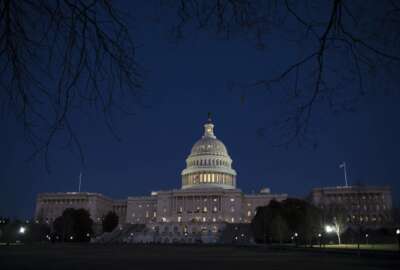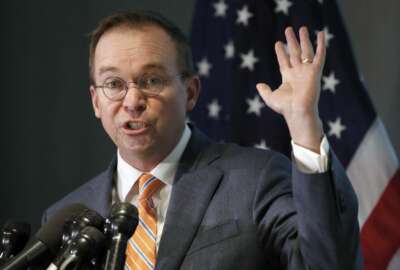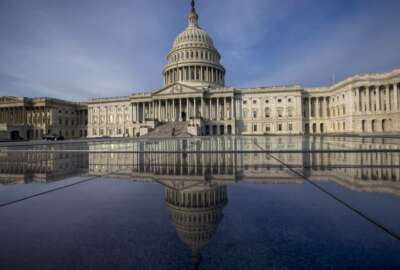
Government shuts down as Senate fails to pass spending bill
The Senate could only muster 50 votes, not 60, to invoke cloture to end debate on the continuing resolution to keep the government open.
Get the latest news about the government shutdown first. Sign up for our breaking news alerts.
The Senate failed to pass the House’s spending bill Friday night and the government is in a partial shutdown for the second time since 2013 and fourth time in the last 25 years.
The House passed a four-week continuing resolution Jan. 18, leaving it to the Senate to avert a partial shutdown.
One of the main reasons for Senate’s failure to pass the House bill that led to the partial shutdown is the Democrats’ demand for concessions on immigration, chiefly protection for thousands of young immigrants facing deportation. Leaders said Thursday they would have the votes to block the House-passed measure that would have funded the government for another four weeks.”
Senate Majority Leader Mitch McConnnell (R-Ky.) said he will be introducing an amendment to the CR to keep the government open until Feb. 8. That amendment could come to the floor on Saturday.
“Feb. 8 is a very reasonable time,” he said after the government shutdown on Saturday morning. “At some point here, we will be voting on Feb. 8, which begins a little bit closer to where our friends on the other side said they wanted to be. A reasonable period of time it takes into account the State of the Union, party conferences and just the amount of time it takes to write a bill once you have an agreement.”
McConnell said the government shutdown was 100 percent avoidable.
“The Senate Democrats chose to filibuster a non-controversial funding bill that contains nothing, not a thing, that they do not support,” he said. “What has their filibuster accomplished? The answer is simple, their very own government shutdown. ”
Senate Minority Leader Chuck Schumer (D-N.Y.) said the blame for the shutdown lies squarely on President Donald Trump, whom he met with earlier in the day to try to hash out a way forward.
“We had the outline of a deal on caps. We had the outline of a deal on health care. We had the outline of a deal on immigration, the toughest issue. It was real. It was an honest to goodness breakthrough. We could have passed a short-term extension of funding so that we could cross the ‘Ts’ and dot the ‘Is’ and be done with it all. But the dynamic of the past few weeks during which congressional Republicans looked to the President for guidance and the President provided none prevailed again today, unfortunately.”
Schumer said he believes there is a path forward for a spending bill that pleases everyone and it can be reached quickly.
How many federal employees will be furloughed if the shutdown lasts into next week is unclear. For example, the Environmental Protection Agency and the State and Energy departments have told their employees to report for work. EPA has enough no-year or multi-year funding to stay open for another week. Meanwhile, Energy and State also are expecting employees to work another week even if funding lapses into next week.
Meanwhile, the departments of Treasury, Commerce and Health and Human Services could end up furloughing more than 40,000 employees each.
Contingency plans released Friday night show that 659 Executive Office of the President staffers would be allowed to report to duty because they are considered essential workers. More than 1,000 of 1,700 staffers would be furloughed. The number is higher than the Obama administration, which deemed 545 staffers essential in 2015.
A senior administration official told reporters Friday night that they were unsure how many employees agencies would end up furloughing.
In 2013, about 850,000 employees, including half of the Defense Department’s civilian workforce, were out of work for most or all of the 16-day shutdown.
“The difference in my mind between now and 2013 is we have instructed agencies to minimize the impact of the shutdown,” said one official during the press briefing. “My impression is other administrations aimed to maximize the impact of the shutdown. For example, the Transportation Department is keeping the Merchant Marine Academy open. The last administration shut it down. I think during the Clinton administration’s shutdown, they kept it open. There are a number of agencies looking at their lapse plans and updating them and will be able to do more things under the law than they did during the Obama administration.”
The official added that the Labor Department would have more inspectors working to keep mines safe and the Centers for Disease Control and Prevention also would continue to track and provide support during flu season.
Office of Management and Budget Director Mick Mulvaney said earlier in the day that the Obama administration “weaponized” the shutdown, but the Trump administration would keep open air monuments, National Parks and other popular areas open as much as possible.
This is the fourth time since the fiscal year started that Congress has brought the government to the brink of a partial shutdown.
Another administration official said this is why planning to start in earnest until the evening of Jan. 18. Agencies, at that time, started initial notifications of employees that would be furloughed.
The official said formal notifications would start Saturday.
Federal employees and contractors expressed frustration over the lack of communication from some agencies.
“The last thing we wanted to do is to gin up work that in last three times we’ve had these calls has gone away,” said one of the officials. “There is a balance we’ve tried to strike but when it was clear earlier this week and there was more uncertainty than we were accustomed to, we started amping up the plans with agencies.”
Copyright © 2025 Federal News Network. All rights reserved. This website is not intended for users located within the European Economic Area.
Jason Miller is executive editor of Federal News Network and directs news coverage on the people, policy and programs of the federal government.
Follow @jmillerWFED






